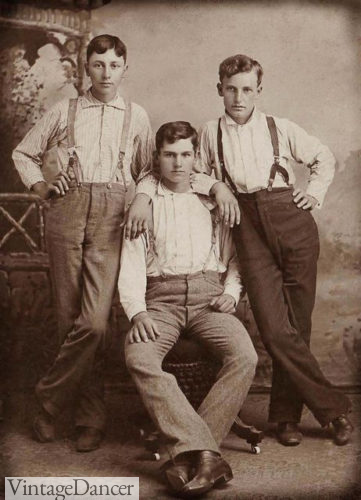Feb 18 2022 - Explore Charles Winchesters board Working Class Dress of the Eighteenth Century on Pinterest. See more ideas about 18th century 18 century art 18th century clothing.
Everyday Clothes This Victorian Life
This flap was universally held in place by two or three buttons at the top.

. Today the working class is not looked on by society as something to aspire to be but the whole class did not exist largely before the 19th century and was instead a peasant class existed that performed labor for lords of the land. A labourers average wage was between 20 and 30 shillings a week in London. In the 19 th-century all women wore several layers of clothing though the clothing got more complicated depending on their socioeconomic status.
Fashionable dress as seen in our images was only available to the wealthy. Trousers became increasingly fashionable in the first quarter of the 19th century. The London omnibuses needed 16000 drivers and conductors by 1861.
19th Century Urban Working Class. Cutaway Tail Coat 1805-1810. Women and work in the 19th century.
Conductors were allowed to keep four shillings a day out of the fares they collected and drivers could count on 34 shillings a week for a working day beginning at 745 and ending often past midnight. Emma Griffin charts the postwar emergence of working-class history as a scholarly discipline and argues that thanks to the torch-bearers the rationale for it has ebbed away. Aside from the work or lack thereof that upper class Victorian women did the most interesting and noticeable way to distinguish between rich and poor women was clothing.
Working class 19th century fashion Written By vukelj Sunday March 13 2022 Add Comment Edit In 14th century 15th century 16th century 17th century 18th century 19th century Americas ancient T term definition 1995 Thierry Mugler Birth of Venus Dress In 1990-1999 20th century garment analysis LGBTQ. The nineteenth century witnessed an amazing transformation in the political and economic life of Europeans and Americans alike. These women did not have to do manual labor.
Corsetry in the 19th century was not only fashionable but seemingly a trend women were expected to follow there were implications of lax morals if a woman chose not to wear a corset. The images we have today of Victorian women clad in fine fabrics grand dresses bonnets and petticoats are the clothes of the upper classes. The skirts were straight and finished to the mid thigh or below.
Women and work in the 19th century. August 4 2017. Gradually men adopted long trousers rather than knee breeches.
By 1850 the cotton linen and woollen trades were fully mechanised in England. No belts were worn. The single or double breasted frock coat fitted quite closely to the torso and had a waist seam.
Male servants were much more expensive because men were paid much higher wages. For day wear frock coats and straight trousers a short waistcoat and a shirt with a high stiff collar were worn. The lining of the shoulders and upper chest of the coat was sometimes quilted to improve the fit.
In the early 19th century some dandies wore boned corsets to give them a small waist. Short-fronted tailcoats and fitted waistcoats were worn over plain white linen shirts. However towards the end of the period the less restrictive Aesthetic style began to emerge.
Throughout the century service was a major employer of women. At the eve of Industrial change throughout Europe London stood above the other powers. When history emerged as a scholarly discipline in British universities at the end of the 19th century it rarely took.
By the turn of the 19th century breeches pantaloons and trousers worn by all men were sewn with a flap in front called a fall front. In the 19th century a proliferation of womens magazine began to gain influence including Godeys Ladys Book 830 - 1898 Townsends Monthly Magazine 1823 - 1888 and La Follet 1829 - 1892. Most servants were female.
While clothing was determined by the days activities the basic underclothes or foundational layer for all outfits a chemise drawers stockings corset and petticoats remained fairly consistent. Most working class women in Victorian England had no choice but to work in order to help support their families. In order to be considered middle class you had to have at least one servant.
They worked either in factories or in domestic service for richer households or in family businesses. See more ideas about historical fashion historical clothing historical dresses. The fashion of the 19th century is renowned for its corsets bonnets top hats bustles and petticoats.
Tight-fitting pantaloons replaced eighteenth century knee breeches Hessian boots replaced buckled shoes and intricately tied white linen neck cloths became the mark of the true man of fashion. In the late 19th century about 80 of the population of the population was working class. Rural women often made their own hats and.
Womens fashion during the Victorian period was largely dominated by full skirts which gradually moved to the back of the silhouette. They could wear different garments for more rigorous activities and whether those were appropriate activities for ladies they were always appropriate for the working class and enslaved was a source of debate in the 1800s. European Culture - 19th Century Nineteenth-Century Industrialization - Fashion Costume and Culture.
Mar 19 2016 - Explore Bec Banhams board Victorian Working ClassLower Class Clothing 1840-1860 followed by 181 people on Pinterest. In 1800 working-class people wore linen underwear men wore woollen outer clothing and women wore cotton linen and woollen dresses. Ad Browse Discover Thousands of Arts Photography Book Titles for Less.
A North London street 1950s. Clothing Headwear Body Decorations and Footwear through the Ages. The need for a corset could well have been supplanted by alternative styles of dress which did not require a corset although.

Working Class Dress Lovetoknow

Overalls For Women Victorian Fashion Edwardian Fashion Historical Fashion

1910s Men S Working Class Clothing

1840 1849 Fashion History Timeline

Working Class Victorian Life Witness2fashion

Stitching The Fashions Of The 19th Century Who Dressed The 19th Century Elite

A Working Class Family Circa 1880 Victorian Life Victorian Clothing Class Outfit

Working Class Fashion Late 19th Century Ireland R Historicalcostuming
0 comments
Post a Comment